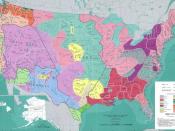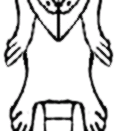At the time of the arrival of Christopher Columbus in the 15th century, the Americas were populated with at least 50 million indigenous people. Understanding the origins of these first Americans will greatly alter the way in which Latin American history is viewed. Incorporating the timeline, technology, language, migration patterns, and ethnic origins of the nomadic ancestors of modern Native Americans provides the information needed to study Latin American in an unbiased fashion.
Until recently, it had been widely accepted that the first Americans on the continent were ice age nomads who arrived here approximately 11,000 years ago. As described in the documentary In Search of History: The First Americans, this theory held that a nomadic people traveled from modern day Russia across the Beringia land bridge connecting them to modern day Alaska. In the past century, many archeological discoveries have lead scientists to believe that the first people in the new world arrived earlier and earlier.
These discoveries began in 1908 in Folsom, New Mexico where George McJunkin finds evidence of a culture that dates back 9,500 years. In the 1920s and 30s, after the discovery of a spear point found in the ribs of a mammoth in Clovis, New Mexico, archeologists began to refer to the first human inhabitants of the new world as the Clovis People. The Clovis people were estimated to have arrived in what is now the United States around 9,000 BCE. Over the next few decades, the Clovis model was generally accepted among scientists and archeologists. Archeological findings in South America began to come to the forefront in the 1970s with the discovery of Monte Verde (Anne Pyburn, 2005). Located on the banks of a Chilean river, the evidence found at Monte Verde suggests that mankind existed in South America 1,000 years before...


